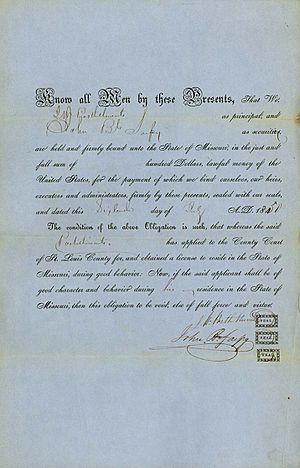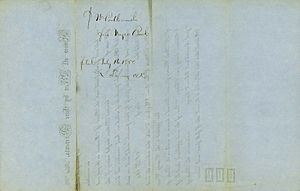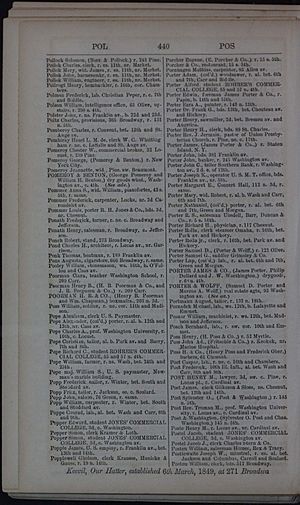Joseph W. Postlewaite facts for kids
Joseph W. Postlewaite was an American musician, composer, and band leader. He was known for organizing bands and orchestras in the mid-1800s. Born in Missouri in 1827, he moved to St. Louis, Missouri, in 1848.
Joseph was the son of Phyllis Benito. He married Eliza Lee, whom he met in Cincinnati, Ohio. Joseph's background was complex. In the 1850 St. Louis Census, he was listed as "mulatto," meaning he was of mixed race. He also applied for a freedom bond in 1850, which was a requirement for free African Americans living in Missouri at the time. This suggests he was considered African American.
Contents
Early Life in St. Louis
When Joseph Postlewaite moved to St. Louis, Missouri was a slave state. However, slavery was becoming less common in the city. Between 1850 and 1860, St. Louis grew a lot, but the number of enslaved people decreased. More European immigrants arrived, which meant less need for enslaved labor.
At that time, all free people of color had to post a bond to live in Missouri. When Postlewaite arrived in St. Louis at age 21, he applied for this bond. A wealthy fur trader named John B. Sarpy signed his bond. It's interesting that Postlewaite signed his bond himself, with a clear signature, unlike most people who used an "X."
Missouri was unusual for a slave state because it allowed some education for Black residents. This, along with the tradition of Black musicians performing for white audiences, helped Postlewaite succeed as a musician during this time.
Musical Career and Compositions
Postlewaite's first song, "Concert Hall Grand Waltz," was likely published in 1845 when he was only 18. It was published by Charles Balmer.
Between 1845 and 1864, Postlewaite published at least 15 musical pieces. Besides music, he also had other jobs. He owned a coffee house in 1857, ran a publishing company in 1858, and possibly a booking agency in 1859. Many of his songs were published by Balmer & Weber. You can find some of his sheet music online.
From 1870 to 1889, Postlewaite published or re-published about 17 more songs. His last known song, "The Veiled Prophets Grand March," was published in 1880. He wrote it for the Veiled Prophet Ball, a big event in St. Louis.
Over his career, Postlewaite started several bands:
- Postlewaite's Quadrille Band (1857)
- Postlewaite's Cotillion Band
- Postlewaite's Four-Man Band (1862)
- Postlewaite's Orchestra (1873)
- The National Band (1873)
- The St. Louis Great Western Band (1874)
- The Great Western Reed and String Band (1875)
In 1880, he led a 16-piece Brass Band that played in parades. His other bands performed at social events, playing popular dance music of the time.
Postlewaite became very well-known and was asked to write music for many special occasions. He wrote at least 37 pieces, mostly dance music popular in 19th-century white society. Even though he played for white society, he likely also performed for St. Louis's large free Black community.
Despite his popularity, Postlewaite's social standing was not as high as the middle-class white or Black residents of St. Louis. However, his musical talent was highly respected. He was even included as a composer and performer at the 1880 Veiled Prophet's Ball, an event for the most important people in St. Louis society.
In 1860, Missouri supposedly forced all free Black residents to leave. But Postlewaite may have stayed in St. Louis because these laws were not strictly enforced. He appears in city directories before and after the Civil War.
Personal Life and Family
Joseph Postlewaite was married to Eliza Postlewaite. After his death, another woman, Annie Papin, claimed to be his legal wife. Annie was related to the Chouteau family, who founded St. Louis. Annie said she and Joseph married on May 5, 1871, and lived in Laclede, Missouri. People in Laclede said Joseph recognized Annie and their two children as his family. Annie came to Eliza's home with her children after reading about Joseph's death.
Eliza Lee, the woman living with Joseph when he died, said she married him in Cincinnati. Eliza was also of mixed race. There was a disagreement about who was Joseph's legal wife.
Later Life and Death
Joseph Postlewaite passed away on New Year's Day in 1889 after being sick for some time. His wife, Eliza, cared for him constantly. Joseph was buried in Calvary Cemetery on January 3, 1889.
Music
Musical Style and Influences
Postlewaite wrote many types of popular dance music from the 1800s, such as waltzes, mazurkas, schottisches, quadrilles, marches, and quick steps. These were common social dances brought to the United States from Europe. Postlewaite knew how to compose these Euro-American dance styles, as well as the dance and folk tunes of the African American community.
His music often followed the structure of Euro-American dance forms, like the Minuet-trio form or Rondo form. He often used five basic chords in his compositions. Some of his pieces, however, mixed these formal structures with folksong tunes. Songs inspired by folksongs often had a short introduction followed by longer sections that repeated. In his "St. Louis Grey's Quick Step," for example, the music follows a minuet-trio form with several sections.
List of Works
| Composition
Number |
Title | Date
Published |
Genre |
|---|---|---|---|
| 1 | Concert Hall Grand Waltz | (1845) | Waltz |
| 2 | Almira Waltz | 1849 | Waltz |
| 3 | Galena Waltz | 1850 | Waltz |
| 4 | Iola Waltz | 1850 | Waltz |
| 5 | Kasky Waltz | 1850 | Waltz |
| 6 | Dew Drop Schottisch | 1851 | Schottish |
| 7 | Eugenia Waltz | 1852 | Waltz |
| 8 | St. Louis Grey's Quick Step | (1852) | Quick Step |
| 9 | Schottisch Quadrille | 1853 | Quadrille |
| 10 | Annie Polka Mazurka | 1854 | Polka/Mazurka |
| 11 | Recreation Schottisch | 1854 | Schottisch |
| 12 | Geraldine's Dream | (1854) | |
| 13 | Bessee Waltz | 1855 | Waltz |
| 14 | St. Louis National Guard's Quick STep | 1855 | Quick Step |
| 15 | Dramatic Schottisch | 1856 | Schottisch |
| 16 | Red Petticoat Mazurka | 1858 | Mazurka |
| 17 | Vis-à-Vis Schottisch | Pre-1859 | Schottisch |
| 18 | Pleyade Schottisch | 1859 | Schottisch |
| 19 | Lillie Polka Mazurka | 1867 | Polka/Mazurka |
| 20 | Bessie Waltz | Pre-1870 | Waltz |
| 21 | Enchanting Mazurka | Pre-1870 | Mazurka |
| 22 | Fairest of the Fair | Pre-1870 | |
| 23 | Fairest of the Fair Polka Redowa | Pre-1870 | Polka/Redowa |
| 24 | General Grey's Quick March | Pre-1870 | March |
| 25 | Home Circle Lancers | Pre-1870 | |
| 26 | Lewellyn Waltz | Pre-1870 | Waltz |
| 27 | Orange Schottisch | Pre-1870 | Schottisch |
| 28 | Point Breeze | Pre-1870 | |
| 29 | Ruth Polka | Pre-1870 | Polka |
| 30 | Evangeline Waltz | Post-1870 | Mazurka |
| 31 | Governor Hendrick's Quick Step | Post-1870 | Quick Step |
| 32 | Aurora Schottisch | Post-1870 | Schottisch |
| 33 | Eliza | Post-1870 | |
| 34 | Knight Templar Quick March | Post-1870 | March |
| 35 | Love's Dream Waltz | 1874 | Waltz |
| 36 | Veiled Prophet's Grand March | 1880 | Waltz |






